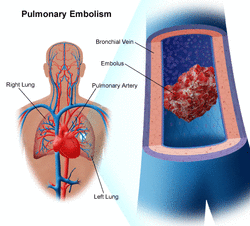Pathology definition - Pulmonary Embolism

Pulmonary embolism
Patient who suffer from pulmonary embolism may complain of pleuritic chest pain, shortness of breath/ dyspnea and chest pain. Patient with pulmonary embolism may also appear lethargy, fatigue, tachycardic and tachypnea.
Pulmonary embolism is mostly associated with deep vein thrombosis of the leg which lead to thromboembolism. Other causes of emboli may include tumor cells, fat, air, foreign bodies and amniotic fluid. Virchow triad need to be considered as the precipitating factors of developing deep vein thrombosis. Virchow triad may include injury to the vessel wall, venous stasis and hypercoagulability.
There will be an elevation of D dimer and ventilation - perfusion mismatch detected. Pathological finding may reveal dark red and pale gray fibrin strands deposited in the pulmonary vessel ( venous thrombosis) and infarction and hemorrhage of the lower lobes due to circulatory inadequacy.
The treatment of pulmonary embolism will focus on thrombolytic therapy.
Patient who suffer from pulmonary embolism may complain of pleuritic chest pain, shortness of breath/ dyspnea and chest pain. Patient with pulmonary embolism may also appear lethargy, fatigue, tachycardic and tachypnea.
Pulmonary embolism is mostly associated with deep vein thrombosis of the leg which lead to thromboembolism. Other causes of emboli may include tumor cells, fat, air, foreign bodies and amniotic fluid. Virchow triad need to be considered as the precipitating factors of developing deep vein thrombosis. Virchow triad may include injury to the vessel wall, venous stasis and hypercoagulability.
There will be an elevation of D dimer and ventilation - perfusion mismatch detected. Pathological finding may reveal dark red and pale gray fibrin strands deposited in the pulmonary vessel ( venous thrombosis) and infarction and hemorrhage of the lower lobes due to circulatory inadequacy.
The treatment of pulmonary embolism will focus on thrombolytic therapy.
